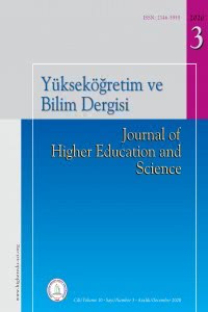Olağanüstü Üstün Yetenekli Öğrencilerin Eğitim Sürecinde Radikal Hızlandırma ve Türkiye'nin Durumu
Üstün yetenekli öğrencilerin akademik, sosyal ve duygusal gereksinimlerini karşılamak için birçok program uygulanmaktadır. Üstün yetenekli öğrencilerin akranlarından üç ya da daha fazla yıl önce üniversiteye girmelerini sağlayan radikal hızlandırma bunlardan biridir. İlk olarak 1971 yılında uygulanmaya başlayan radikal hızlandırma, halen Birleşik Devletler’in, Asya ve Avrupa ülkelerinin birçok üniversitesinde uygulanmaktadır. Radikal hızlandırmanın üstün yetenekli bireylerde olumsuz bir etkisinin olmadığı, aksine önemli kazanımlar sağladığı ile ilgili birçok araştırma bulunmaktadır. Bu çalışmada; radikal hızlandırmanın ne olduğu, üstün yetenekli bireylerdeki kazanımları ve uygulamasıyla ilgili öneriler incelenmiştir. Ülkelerin radikal hızlandırma durumları yanında Türkiye’nin yasal düzenlemeleri sunulmuştur
Anahtar Kelimeler:
Radikal hızlandırma, Olağanüstü yetenekli öğrenciler, Yükseköğretim
Radical Acceleration in Educational Process of Highly Gifted Students and the Situation of Turkey
A number of programs are implemented in order to meet cognitive, social and emotional needs of gifted students. One of them is the radical acceleration that ensures gifted students gaining access to university three or more years before than their peers. First performed in 1971, radical acceleration is currently implemented in many universities in United State and Asian and European countries. There are many researches on radical acceleration showing that it has no negative impacts on gifted students, rather it provides important outcomes. This study investigated radical acceleration and its outcomes on gifted students, as well as suggestions regarding to its application. Finally, situation of many countries in terms of radical acceleration, and legal regulations in Turkey’s were presented
Keywords:
Radical acceleration, Highly gifted students, Higher education,
___
- Ataman, A. (2003). Üstün Zekâlı/Yetenekli Çocuklar. Özel Gereksinimli Çocuklar ve Özel Eğitime Giriş. Ankara: Gündüz Eğitim ve Yayıncılık.
- Bilim ve Sanat Merkezi Yönergesi. Erişim: http://mevzuat.meb.gov. tr/html/2593_0.html
- Renzulli, J. S. (1977). The enrichment triad model: A guide for developing defensible programs for the gifted and talented. Mansfield Center, CT: Creative Learning Press.
- Renzulli, J. S., & Reis, S. M. (1985). The school wide enrichment model: A comprehensive plan for educational excellence. Mansfield Center, CT: Creative Learning Press.
- Renzulli, J. S. (1999). What is thing called giftedness, and how do we develop it? A twenty-five year perspective. Journal for Education of Gifted, 23(1), 3-54.
- Richardson, T. M., & Benbow, C. P. (1990). Long-term effects of acceleration on the social emotional adjustment of mathematically precocious youths. Journal of Educational Psychology, 82(3), 464-70.
- Rogers, K. B. (2002), Effects of acceleration on gifted learners. M. Neihart, S. Reis, N. Robinson, & S. Moon, (Eds.), The Social and emotional development of gifted children: What do we know? (pp. 3–12). Waco, TX: Prufrock Press.
- Rotigel, J. V., & Lupkowski-Shoplik, A. (1999). Using talent searches to identify and meet the educational needs of mathematically talented youngsters. School Science and Mathematics, 99(6), 330-37.
- Sak, U. (2010). Üstün zekalılar, özellikleri tanılanmaları eğitimleri. Ankara: Maya Akademi Yayınevi.
- Sayler, M. F. (1994). Early college entrance: A viable option. In J. N. Hansen & S. M. Hoover (Eds.), Talent Development: Theories and Practice (pp. 67–79). Dubuque, IA: Kendall/Hunt.
- Sharkey, O. C. (1987). Tony Lai, age 14, B.Sc., prodigy. Roeper Review, 10(2), 94-96.
- Sisk, D. A. (1992). Reflections and impressions on education in China. Roeper Review, 14(4), 181-185.
- Stanley, J. (1978). Educational non-acceleration: An international tragedy. Gifted Child Today, 1(3), 2-5
- Steenbergen-Hu, S., & Moon, S. M. (2011). The effects of acceleration on high ability learners: A meta-analysis. Gifted Child Quarterly, 55 (1), 39-53.
- Southern, W. T., Jones, E. D., & Stanley, J. C. (1993). Acceleration and enrichment: The context and development of program options. K. A. Heller, F. J. Mönks, & A. H. Passow (Eds.), International handbook of research and development of giftedness and talent (pp. 387–405). New York: Pergamon.
- Tomlinson, C. A., Kaplan, S. N., Renzulli, J. S., Purcell, J., Leppien, J., & Burns, D. (2002). The parallel curriculum: A design to develop high potential and challenge high-ability learners. Washington, DC: National Association for Gifted Children.
- van Tassel-Baska, J. (1986). Effective curriculum and instruction models for talented students. Gifted Child Quarterly, 30, 164–169.
- van Tassel-Baska, J. (2005). Gifted Programs and Services: What are the Negotiables? Theory Into Practice, 44(2). Columbus OH: The Ohio State University.
- YÖK (2007). Türkiye’nin yükseköğretim stratejisi. YÖK Yayın No. 2007/1. Ankara: Meteksan A.Ş.
- Zeidner, M., & Schleyer, E. J. (1999). The big-fish-little-pond effect for academic self-concept, test anxiety, and school grades in gifted children. Contemporary Educational Psychology, 24, 305-329. id_10096.aspx
- ISSN: 2146-5959
- Yayın Aralığı: Yılda 3 Sayı
- Başlangıç: 2011
- Yayıncı: Bülent Ecevit Üniversitesi (Önceden Zonguldak Karaelmas Üniversitesi)
Sayıdaki Diğer Makaleler
Yaşamboyu Öğrenme: Kavram, Politika, Araçlar ve Uygulama
Yükseköğretim Kurumlarında Öğrenci Sadakati
MİNE GÜLDEN POLAT, MAKBULE KALI SOYER, Ayşegül YILDIRIM KAPTANOĞLU
Bologna Süreci'nin Avrupa Yükseköğretim Sistemi Üzerine Etkileri
Yükseköğretimde Küresel Bir Değişim: Girişimci Üniversite Modeli
Süreyya SAKINÇ, Sibel AYBARÇ BURSALIOĞLU
Psikopatolojik Sanat ve Psikiyatrik Tedavide Sanatın Kullanılışı
Olağanüstü Üstün Yetenekli Öğrencilerin Eğitim Sürecinde Radikal Hızlandırma ve Türkiye'nin Durumu
